Czech Cuisine: A Deep Dive into Traditional Czech Food
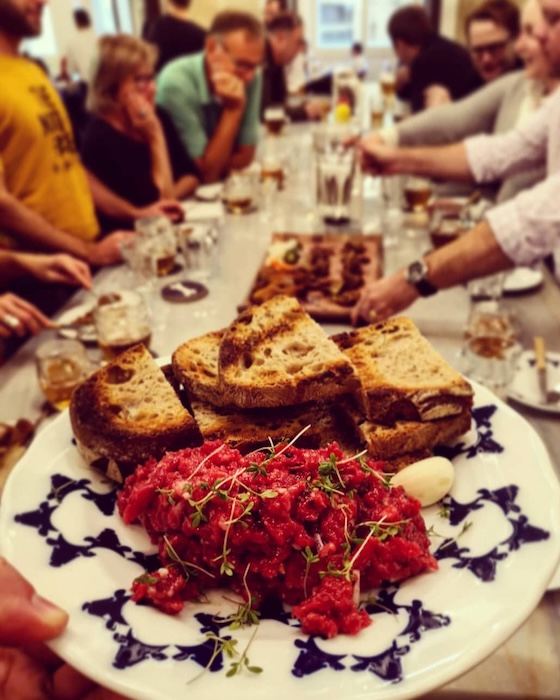
Czech cuisine is a distinct and flavorful part of Central European gastronomy. It's known for its hearty, comforting dishes, rich sauces, and an emphasis on meats, dumplings, and soups. Traditional ingredients include onions, garlic, butter (or lard), potatoes, flour, salt, pepper, cumin, and marjoram. If you step into any Czech household, chances are you'll find these ingredients readily available.
Interestingly, Czechs also have a deep love for poppy seeds and mushrooms. Mushroom picking in the forests is almost a national pastime, especially on Sundays when families head out with baskets in hand, searching for the perfect boletus or chanterelle.
When asked to describe Czech cuisine, I often compare it to Bavarian food. It is undoubtedly on the heavier side, but it's important to remember that what we now consider traditional Czech cuisine was once reserved for Sundays or special occasions. Meat, which now forms the base of most Czech meals, was historically a luxury. Today, a standard Czech menu typically consists of three parts: a soup, a main dish, and either a dessert, compote, or vegetable salad.
If you'd like to experience authentic Czech flavors firsthand, we also offer private food tours in Prague, where you can taste traditional dishes, learn about local ingredients, and discover the stories behind Czech culinary traditions.
This article explores the essential dishes of Czech cuisine, highlighting the most famous and beloved traditional foods in each category.

Soups: The Essential Start to Any Czech Meal
(Polévky)
One of the defining features of Czech cuisine is the absence of a formal starter course. Instead, most meals begin with a soup, even in budget-friendly lunch menus. Czech soups are either clear broths or thick, hearty varieties made using jíška - a roux of flour and butter.
Popular Czech Soups:
Bramboračka – Traditional potato soup with mushrooms and root vegetables.
Gulášová polévka – Goulash soup, a thick and spicy beef stew-like soup.
Dršťková polévka – Tripe soup, a flavorful dish often enjoyed with fresh bread.
Česnečka – Garlic soup, known for its warming and healing properties, often served with croutons and cheese.
Zelňačka – Cabbage soup with sausage, sour and savory at the same time.
Hovězí vývar – Beef broth with liver dumplings and noodles.
Kulajda – A creamy dill soup with potatoes, mushrooms, and a poached egg.
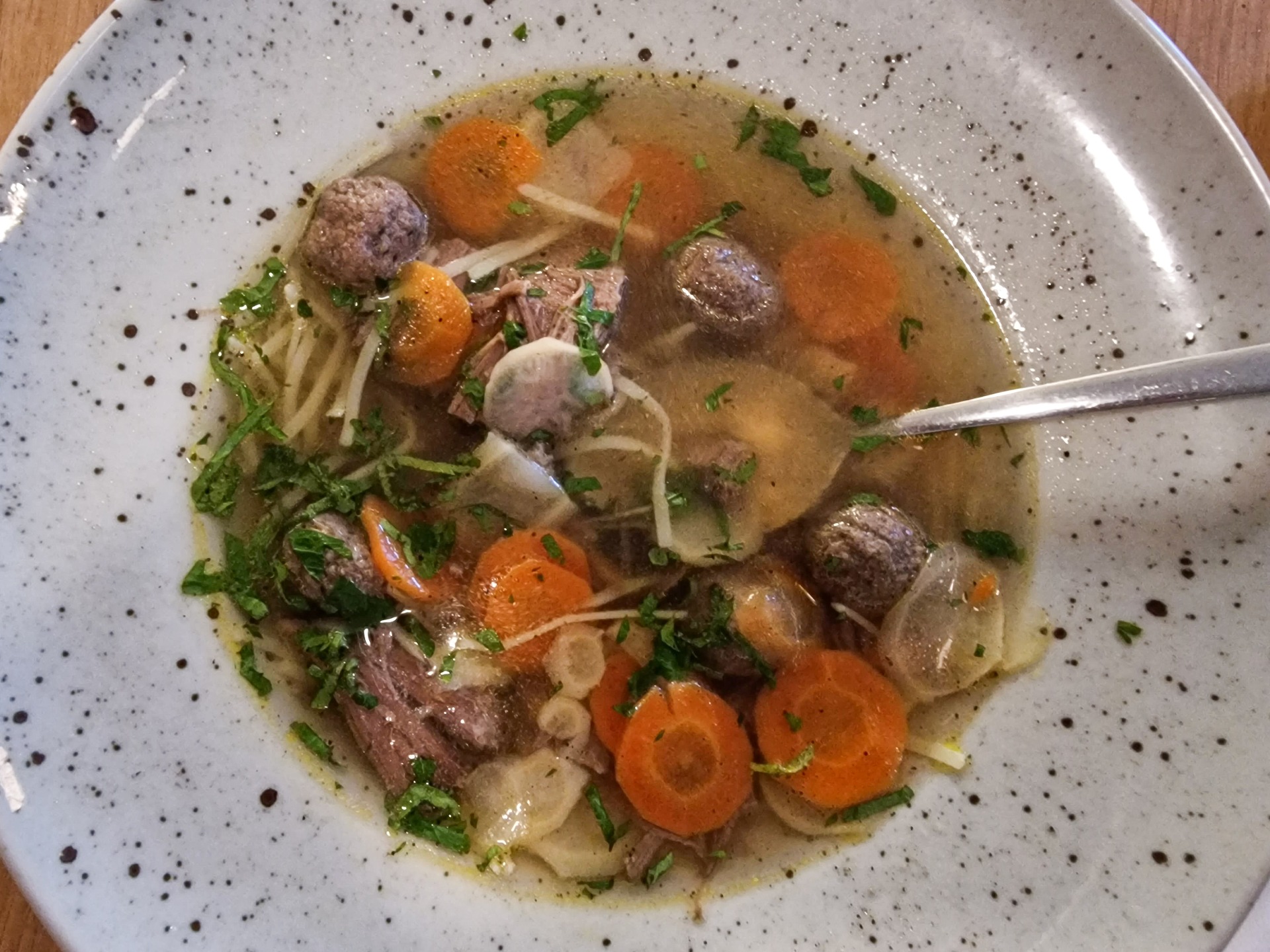
Main Dishes: Hearty and Flavorful
(Hlavní jídla)
Meat-Based Dishes
Meat is at the heart of Czech cuisine, with pork, beef, and poultry being the most commonly consumed. Dishes often come with dumplings (knedlíky), potatoes, or rice.
Vepřo knedlo zelo – Roast pork with dumplings and sauerkraut, a Czech national dish.
Svíčková na smetaně – Marinated beef sirloin in a creamy vegetable sauce, served with dumplings and cranberry sauce.
Guláš – Czech goulash, a rich beef stew usually accompanied by bread dumplings.
Pečená kachna – Roast duck with dumplings and cabbage.
Rajská omáčka – Sweet tomato sauce served with beef and dumplings.
Koprová omáčka – Dill sauce served with beef and dumplings.
Kuře na paprice – Chicken in a creamy paprika sauce.
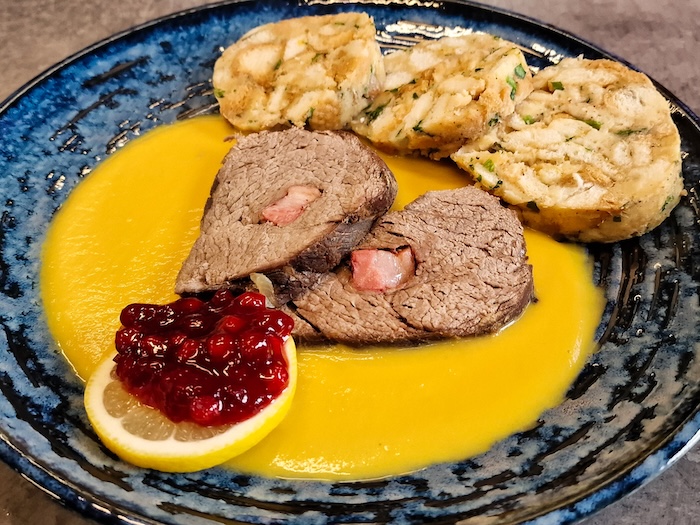
Sweet Dishes
A unique feature of Czech culinary tradition is that some sweet meals are actually served as main courses, not desserts – something quite unusual in most other cuisines.
Ovocné knedlíky – Fruit-filled dumplings made with dough and topped with melted butter and sugar.
Buchtičky se šodó - Small sweet yeast buns served warm with vanilla custard sauce.
Žemlovka – A baked bread pudding with apples and cinnamon.
Lívance – Czech-style pancakes, usually served with jam or sour cream.
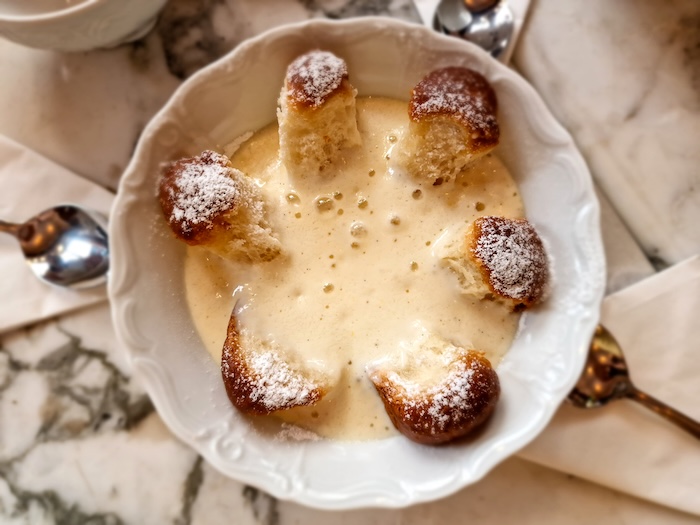
Vegetarian Dishes
While Czech cuisine is traditionally meat-heavy, there are several delicious vegetarian dishes worth trying. Many sweet dishes are naturally vegetarian, but there are also savory options.
Smažený sýr / Smažák (Fried cheese) – A popular Czech dish consisting of deep-fried cheese, usually served with tartar sauce and fries or boiled potatoes.
Bramboráky – Crispy potato pancakes flavored with garlic and marjoram, often enjoyed as a snack or side dish.

Traditional Czech Snacks
Whether you're grabbing a quick bite or enjoying a beer at a pub, these Czech snacks are a must-try:
Chlebíčky – Open-faced sandwiches topped with ham, egg, cheese, or potato salad.
Párek v rohlíku – Czech-style hot dog, similar to an American one but with a unique serving method.
Tlačenka – Head cheese (meat jelly), often served with vinegar and onions.
Utopenec – Pickled sausage served with onions and vinegar.
Bramboráky – Czech potato pancakes, crispy and flavorful.
Nakládaný hermelín – Marinated Camembert-like cheese, served with bread and pickles.
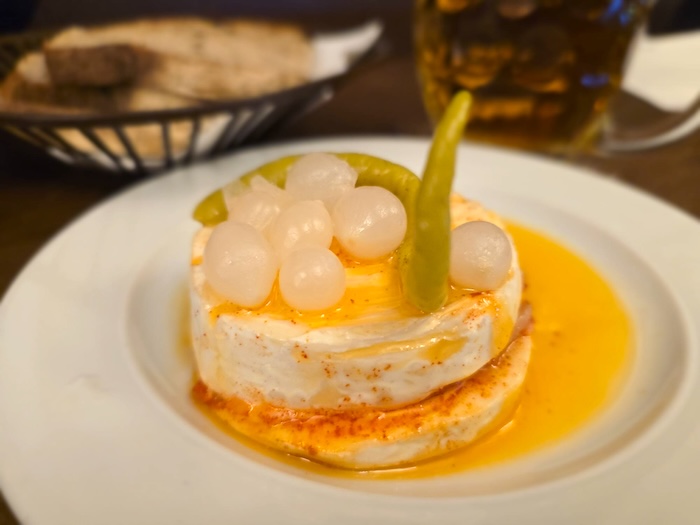
Traditional Czech Desserts
(Dezerty)
No Czech meal is complete without a sladká tečka na závěr, or a sweet finishing touch. Czech desserts are rich in flavor, often incorporating fruit, nuts, and traditional dairy ingredients.
While the chimney cake, or trdelník (spiral-shaped pastry dusted with cinnamon and sugar), is available on nearly every street corner, it is not actually a traditional Czech dessert. But what does belong among typical Czech desserts is:
- Medovník – Layered honey cake with a rich caramelized flavor.
- Větrník – Choux pastry filled with vanilla and caramel cream, light yet indulgent.
- Indiánek – Chocolate-covered marshmallow on a biscuit base, perfect for chocolate lovers.
- Koláč - Sweet yeasted pie typically filled with poppy seeds, fruit, jam, or quark. Koláče are especially traditional in some regions of the Czech Republic, often served at festive occasions and family gatherings.
- Buchta – Soft, oven-baked bun filled with plum jam, quark, or poppy seed paste.
- Kobliha – Fluffy deep-fried doughnut (without the hole!), usually filled with jam and dusted with powdered sugar.
- Kremrole – Crispy puff-pastry roll filled with sweet meringue cream.
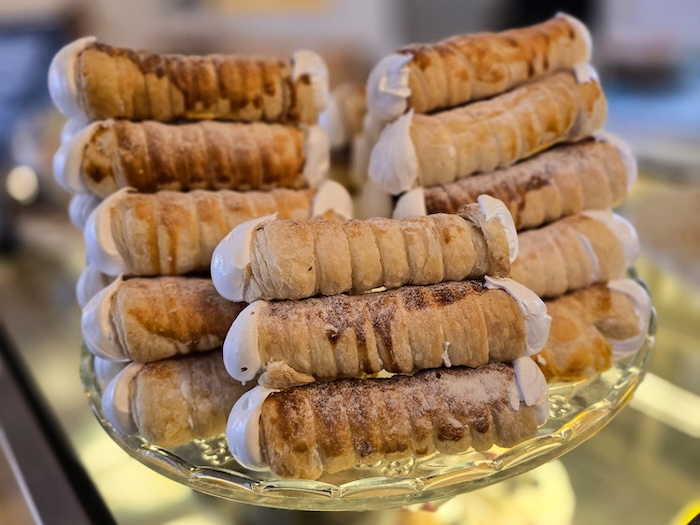

Drinks: Czech Beverages You Must Try
(Nápoje)
Alcoholic Drinks:
Pivo – Beer is a cornerstone of Czech culture, with the country boasting the highest beer consumption per capita in the world. Try famous brands like Pilsner Urquell, Budvar, and Kozel.
Slivovice – Plum brandy, a potent traditional spirit.
Becherovka – A herbal liqueur with a unique cinnamon and clove flavor.
Meruňkovice – Apricot brandy, another popular fruit-based spirit.
Hot Beverages:
Svařák – Hot mulled wine, perfect for winter markets.
Čaj – Tea, often served with honey and lemon.
Káva – Coffee, usually strong and black, or served as espresso.
Non-Alcoholic Drinks:
Kofola – The Czech alternative to Coca-Cola, with a unique herbal taste.
Mattoni – A famous Czech mineral water brand.
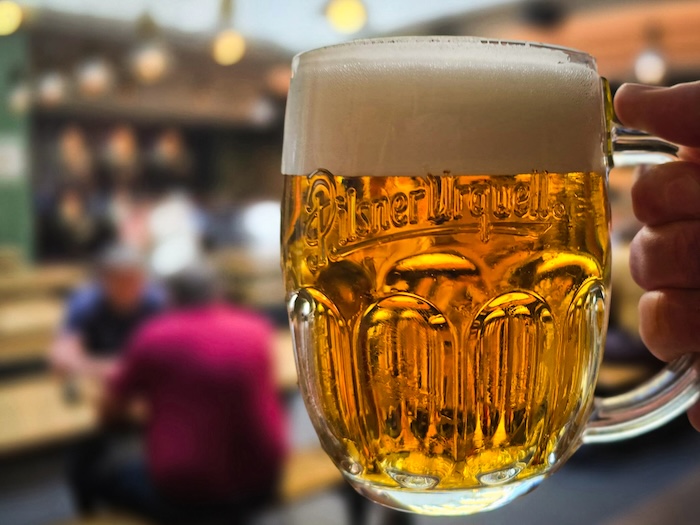
Food for Special Occasions
Czechs love to celebrate with food, and certain dishes are strongly tied to holidays and traditions:
Bramborový salát – Czech potato salad, an essential dish for Christmas Eve dinner.
Vánoční cukroví – Traditional Christmas cookies, made in various shapes and flavors.
Kapr – Carp, traditionally served fried with potato salad for Christmas.
Velikonoční beránek – Easter lamb-shaped cake, symbolizing new beginnings.
Mazanec – A sweet Easter bread, often studded with almonds and raisins.

A Taste of Czech Tradition
Czech cuisine offers a true taste of the country's history, culture, and hearty traditions. From savory classics like svíčková and vepřo knedlo zelo to comforting soups and irresistible desserts such as koláč and větrník, every dish tells a story of Czech hospitality and craftsmanship. Whether you're dining in a rustic village pub or a modern Prague restaurant, exploring Czech food means discovering the warmth, flavor, and soul of Central Europe – one delicious bite at a time.
If you'd like to taste some of these instead of just reading about it, join our Prague Food Tour – we'll show you where locals actually eat. And if you're looking for more inspiration on where to eat and drink, don't miss our guide Tried & Tested: The Best Food and Drink Spots in Prague, featuring our favorite restaurants, cafés, and bars across the city.
